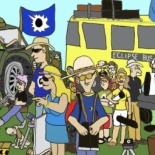
|
www.eclipse-chasers.com Gallery Report Programmer: Bill Kramer Last update: April 17 2015 |
Eclipse Chaser
(noun) - Anyone that wants to see a total solar eclipse.  Search Eclipse Chasers Site
Search Eclipse Chasers Site |
Report
Bill Kramer report from the Olympia sailing in the North Atlantic.Three years after man had first landed on the moon, this was a golden time for science and many young people like myself where drawn to it with wild enthusiasm. I was 13 at the time and was an experienced amateur astronomer armed with an SLR camera and 210 mm lens on a tripod. I’d read the Kodak information on how to photograph an eclipse and felt ready for action. None of that information covered the topic of taking a picture from a floating platform though.
From the rolling deck of a ship in the middle of the North Atlantic, I was able to obtain several decent photographs. The trick is to time your photograph exposures to start and stop as the ship is at the maximum or minimum of the roll. For a smaller ship, you cannot take as long of a picture as you can from a larger vessel. Even in calm seas, the ship is going to roll with the natural wave motion of the ocean.
The film I used was a low speed print film, ASA 125. Corona detail was visible in the longer exposures, but many had "football" shaped moons. As it turned out I had made a critical mistake. Most photo developers are not set up to handle astro-photography and as a result, the printed photos came out with a green background. They were not able to get the color right. Because of that experience, all my subsequent pictures of eclipses have been done using slide film. The results have been much more satisfying.
I was quite eager to get as many good pictures as possible and shot the entire roll of film before totality was finished thus missing a shot at the diamond ring. This is not uncommon amongst novice eclipse photographers. One gets propelled by the momentum of the moment. As such, I watched it happen - and that is something you will never forget seeing.
The best results were obtained using a range of exposures from 1/250 to 1 second. The longer the exposure, the more overexposed the inner corona details become. My goal was to get a series of photographs and someday combine them into a composite showing the entire coronal structure.
The eye is much better at dealing with the variable brightness of the total solar eclipse than the camera. The sinewy tentacles of the corona emerging from the total black of the moon almost seem to dance in a furnace of million degree temperatures, a white hot gas flame of tremendous proportion. But, near the moon’s limb, moving gracefully in it’s orbit, one can see the chromosphere in deep crimson red. From it, the prominences jump forth in a fiery froth frozen in both size and distance.
This was my first eclipse and my first time ever on a cruise ship. It was an exciting adventure even though all we cruised to was Nova Scotia in Canada. The ship was a Greek liner and the entire crew was Greek as well. That added a real flavor to the whole affair, especially in the galley! I had also brought my Edmund 4.25" f/10reflecting telescope. Using a 1" eyepiece (about 40x) the view was stunning and I almost could not look away.
After totality, the best comment heard came from a little girl whose father was a planetarium director. She blurted out, "Do it again Daddy!". But the most frequent comment heard amongst fellow eclipse watchers was "When and where is the next one?". The ship even flew a special flag designed just for the moment.
An eclipse is a surreal event. Moments after it finishes, the memory is blurred and detail becomes harder to recall. After all, the sun just went out on a perfectly clear day. It was spectacular and wonderful, like a dream, but better.
As fourth contact was passing, all I could think about was getting my pictures developed and how to get to the next eclipse. By the way, I wasn't the only one who felt that way!
